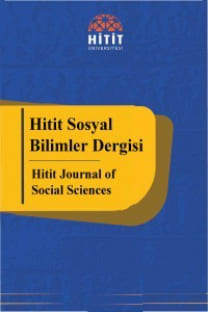FEN ÖĞRETİMİNDE HARMANLANMIŞ ÖĞRENME: AVANTAJLAR VE ÖĞRENCİ ALIŞKANLIKLARI
Sınıf içi yüz yüze öğretim ve uzaktan öğretimin kendine özgü avantaj ve dezavantajları bulunmaktadır. Harmanlanmış öğrenme her iki öğrenme ortamının avantajlı yönlerinin kullanımını esas almaktadır. Bu araştırma, harmanlanmış öğrenmenin öğrencilere sağladığı avantajları belirlemeye yönelik bir anket çalışmasıdır. Çalışma yükseköğretim seviyesinde, okul öncesi öğretmenliği bölümünde öğrenim gören öğrencilerle yürütülmüştür. Fen Eğitimi dersi kapsamında yapılan harmanlanmış öğrenme uygulamasına katılan 33 öğrenci hazırlanan ankete katılmıştır. Veri toplama aracı olarak kullanılan anket iki temel bölümden oluşmaktadır. Birinci bölüm harmanlanmış öğrenmenin avantajlarını belirlemeyi (11 madde), ikinci bölüm ise uzaktan öğretim uygulamalarında öğrenci alışkanlıklarını belirlemeyi (4 madde) hedeflemektedir. Yapılan betimleyici istatistiksel analiz sonucunda harmanlanmış öğrenmenin belirlenen maddeler boyutunda orta ve üzeri düzeyde avantajlarının olduğu ortaya çıkmıştır. Ayrıca öğrencilerin internet üzerinden yapılan çalışmalara günde ortalama 60 dakika ayırdığı görülmüştür.
Anahtar Kelimeler:
Harmanlanmış Öğrenme, Yükseköğretim, Fen Öğretimi
___
- AKKOYUNLU, B., & SOYLU, M. Y. (2006). A study on students' views on blended learning environment. Turkish Online Journal of Distance Education, 7(3), 43-56.
- ALISON, C. C., & PHILIP, D. (2000). The ideal online course. British Journal of Educational Technology, 31(3), 229-241. doi: doi:10.1111/1467-8535.00154
- ARKORFUL, V., & ABAIDOO, N. (2015). The role of e-learning, advantages and disadvantages of its adoption in higher education. International Journal of Instructional Technology and Distance Learning, 12(1), 29-42.
- BAWANEH, S. S. (2011). The effects of blended learning approach on students’ performance: Evidence from a computerized accounting course. International Journal of Humanities and Social Science, 1(6), 63-69.
- BERG, G. A. (1998). Public Policy on Distance Learning in Higher Education: California State and Western Governors Association Initiatives. Education Policy Analysis Archives, 6(11).
- BISHOP, K., & DENLEY, P. (2007). Learning Science Teaching. England: Open University Press.
- BRANSFORD, J. D., BROWN, A. L., & COCKING, R. R. (2000). How people learn : brain, mind, experience, and school (Expanded ed.). Washington, D.C.: National Academy Press.
- CHEN, P.-S. D., LAMBERT, A. D., & GUIDRY, K. R. (2010). Engaging online learners: The impact of Web-based learning technology on college student engagement. Computers & Education, 54, 1222–1232.
- ECHO360. (2011). The Student View of Blended Learning. Retrieved 25 April, 2016, from https://echo360.com/
- GARRISON, D. R. (2009). Blended Learning as a Transformative Design Approach. In P. L. Rogers, G. A. Berg, J. V. Boettcher, C. Howard, L. Justice & K. D. Schenk (Eds.), Encyclopedia of Distance Learning (SE ed.). United States of America IGI Global.
- GÜRBÜZ, S., & ŞAHIN, F. (2014). Sosyal Bilimlerde Araştırma Yöntemleri. Ankara: Seçkin Yayıncılık.
- JUNCO, R., HEIBERGER, G., & LOKEN, E. (2011). The effect of Twitter on college student engagement and grades. Journal of Computer Assisted Learning, 27(2), 119-132. doi: 10.1111/j.1365-2729.2010.00387.x
- KEENGWE, J., ONCHWARI, G., & ONCHWARI, J. (2009). Technology and Student Learning: Toward a Learner- Centered Teaching Model. Association for the Advancement of Computing in Education Journal, 17(11), 11-22.
- MCKENZIE, W. A., PERINI, E., ROHLF, V., TOUKHSATI, S., CONDUIT, R., & SANSON, G. (2013). A blended learning lecture delivery model for large and diverse undergraduate cohorts. Computers & Education, 64, 116-126. doi: 10.1016/j.compedu.2013.01.009
- MIYAZOE, T., & ANDERSON, T. (2011). Anonymity in Blended Learning: Who Would You Like to Be? Educational Technology & Society, 14(2), 175–187.
- SJØBERG, S. (2007). Constructivism and learning. In E. Baker, B. McGaw & P. P. (Eds.), International Encyclopaedia of Education (3 ed.): Oxford: Elsevier.
- VALENTINE, D. (2002). Distance Learning: Promises, Problems, and Possibilities. Online Journal of Distance Learning Administration, 5(3), 1-11.
- WITTA, E. L. (2009). Achievement in Online vs. Traditional Classes. In P. Rogers, G. Berg, J. Boettcher, C. Howard, L. Justice & K. Schenk (Eds.), Encyclopedia of Distance Learning (2 ed.). United States of America: Information Science Reference.
- WMFC. (2018). Generational Differences Chart. Retrieved 28 Haziran, 2018, from http://www.wmfc.org/uploads/generationaldifferenceschart.pdf
- YıLMAZ, Ö. (2017). Yükseköğretimde Harmanlanmış Öğrenme: Fen Eğitimi Dersi Uygulamasına Yönelik Öğrenci Görüşleri. In S. K. Aynur B. BOSTANCI (Ed.), Eğitim Araştırmaları ve Öğretmen Eğitimi (pp. 133-142). Ankara: EYUDER Yayınları.
- YUKSELTURK, E., & BULUT, S. (2007). Predictors for Student Success in an Online Course. Educational Technology & Society, 10(2), 71-83.
- Yayın Aralığı: Yılda 2 Sayı
- Başlangıç: 2008
- Yayıncı: Hitit Üniversitesi
Sayıdaki Diğer Makaleler
NAMIK KEMAL’S ECONOMIC THOUGHTS
HİTİTLERDEN ETKİLENEN ÖNCÜ ÇAĞDAŞ TÜRK SERAMİK SANATÇILARI
NİF OLYMPOS DAĞI ANTİK DÖNEM İNSANLARININ SAĞLIK SORUNLARI
Alper Yener YAVUZ, Ayla SEVİM EROL, İbrahim Semih ONUR
MARX, DURKHEIM VE WEBER ÜZERİNDEN KLASİK DÖNEM SOSYOLOJİSİNDE MODERN DEVLET VE MODERN ORDULAR
TÜRKİYE’NİN, BÖLGELERİN VE İLLERİN SAĞLIK DEĞİŞKENLERİ AÇISINDAN MEVCUT DURUMU VE SIRALANMASI
AKMONİA YÜZEY ARAŞTIRMALARINDA ELE GEÇEN TERRA SİGİLLATALAR VE GEÇ ROMA KIRMIZI ASTARLI SERAMİKLERİ
TOPLAM KALİTE YÖNETİMİNİN ÖRGÜTSEL VATANDAŞLIK DAVRANIŞI İLE İLİŞKİSİ
Zekai ÖZTÜRK, Ayşe Nur TÜRKOĞLU, Feride DÜŞÜNGÜLÜ
İMAM-HATİP LİSESİ SON SINIF ÖĞRENCİLERİNİN MESLEKİ YETERLİK ALGISI
